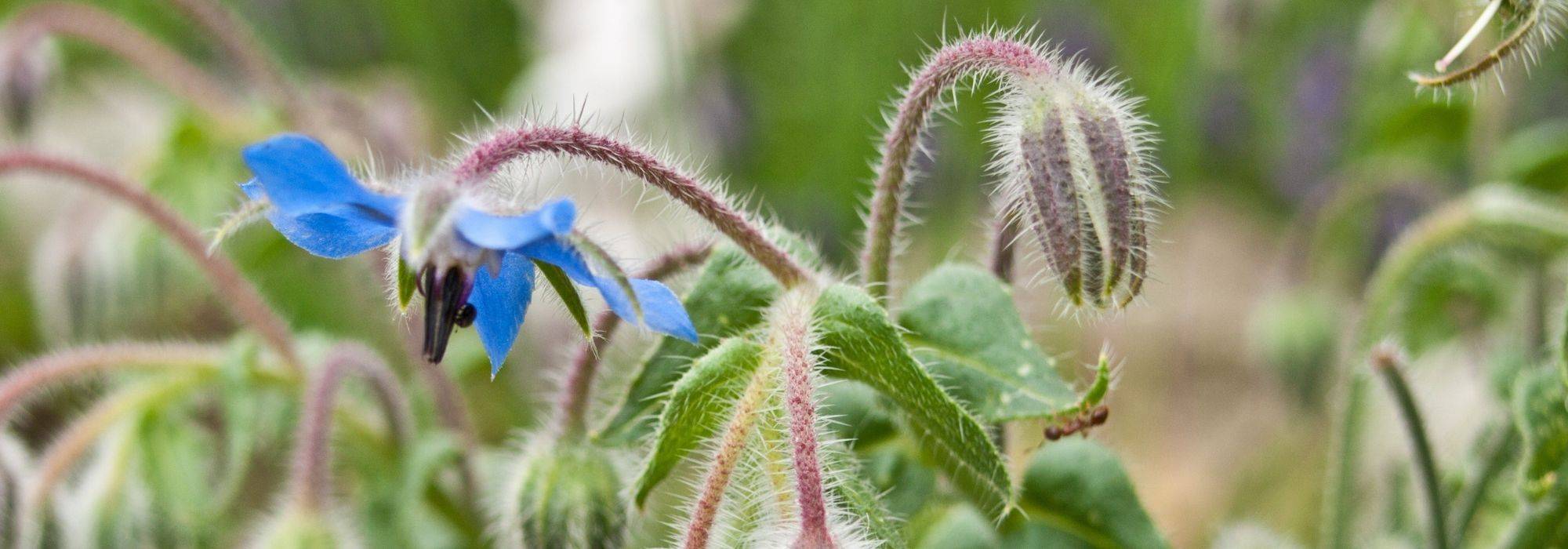
Borage: sowing, harvest, benefits
Contents
Borage in a nutshell
- Borage is a medicinal and ornamental plant appreciated for its pretty flowering, but also for its benefits
- Its star-shaped blue flowers, more rarely white, and its villous leaves are harvested to flavour salads and herbal teas
- Borage oil from its seed is used to help maintain beautiful hair and skin
- It is also useful in the vegetable garden in permaculture as green manure and self-seeds spontaneously
- It is a plant to sow or transplant in vegetable garden or ornamental garden
A word from our expert
Known since Antiquity for medicinal properties, Borage is a pretty ornamental, culinary vegetable plant whose multiple benefits are concentrated in capsules, pills or as an infusion!
While its magnificent star-shaped blue or white flowers adorn many recipes and its leaves can be enjoyed raw or cooked, its seeds yield borage oil, often combined with that of evening primrose, much appreciated in recent years for richness in antioxidants: natural weapon to fight skin ageing, preserve beauty of face and hair!
Easy to grow, plant or sow borage without hesitation: its leaves and fresh flowers, finely chopped in salads, will release their iodised flavour.
Highly melliferous, attracting pollinating insects, borage is also useful in vegetable garden when grown alongside your crops. It is also widely used in permaculture as a green manure! An annual prone to self-seeding, it will therefore reseed itself the following year!
With its bushy silhouette and starry flowering, borage naturally finds its place in vegetable garden herb squares but will also fit effortlessly into natural, wild gardens or romantic ones!
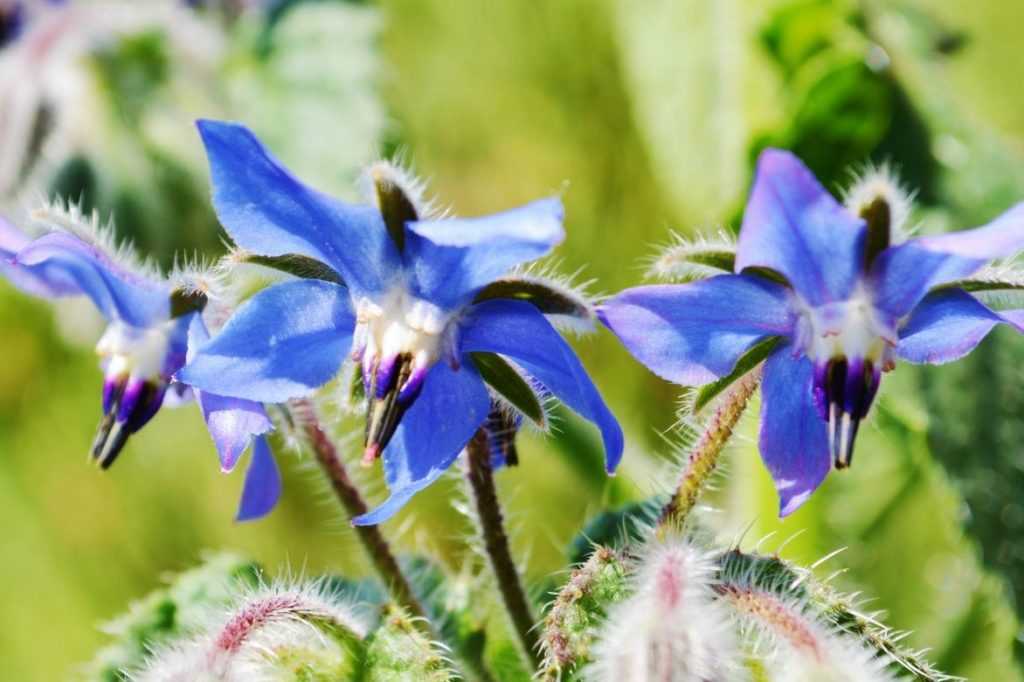
Description and botany
Botanical data
- Latin name Borago officinalis
- Family Boraginaceae
- Common name Borage, Ox-tongue, Broad-leaved bugloss
- Flowering May to September
- Height 0.30 to 0.60 m
- Sun exposure Sun, partial shade
- Soil type All, fresh
- Hardiness Susceptible to frost
Borage, Borago in Latin, also called Ox-tongue or Broad-leaved bugloss, is an annual to biennial herbaceous plant of family Boraginaceae native to Mediterranean and eastern regions, particularly uncultivated lands of Syria. It has naturalised in our gardens and has since colonised roadside verges, waste and rocky ground and sunny banks in Europe where it self-seeds abundantly.
It is grown in our climates as an annual, although it can sometimes survive in regions with mild winters. Common borage, or Borago officinalis, with its magnificent star-shaped blue flowers is most widespread species. There is a white-flowered variety Borago officinalis ‘Alba’.
On a large taproot, this vegetable plant forms a bushy tuft of erect stems sometimes very ramified in upper parts 30 to 60 cm high. It is a fast-growing plant that self-seeds very easily, which can make it undesirable at times.
These thick, pubescent stems covered with small stiff hairs bear deciduous, ample foliage reminiscent of nettle leaves. Basal leaves of the clump are larger and long petiolate, forming a rosette, while upper leaves are sessile, embracing and decrease in size toward the stem tip. Leaves are alternate, lanceolate, acuminate, ovate to elliptical and measure 10 to 15 cm long.
They display a wrinkled aspect with prominent veins and are bristly with stiff hairs. Entire plant is covered with short hairs characteristic of family Boraginaceae. These mid- to dark-green, villous leaves have a rough texture that gave plant its name, which in Latin means “buret”. They are reputed to hinder slugs’ progress! Edible and with a surprising cucumber-like tang, young leaves can be eaten cooked like spinach or raw in salads.
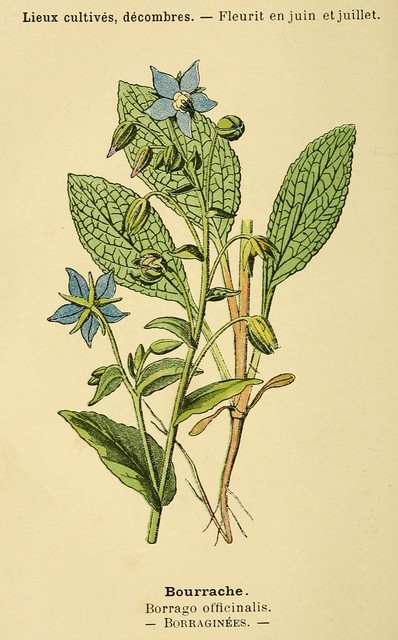
Borago officinalis – botanical illustration
On this pubescent, rough vegetation, small star-shaped, pilous flowers also appear from spring to summer, depending on climate, from March in southern France and succeeding one another until September.
Flowers gathered in a loose terminal cyme shaped like a crozier are borne on a long pilous peduncle. Slightly nodding, they consist of five narrow, fused sepals arranged star-wise and alternating with the pilous petals. At their centre they enclose a white, pointed cone of five purple-black stamens, inserted at base of corolla between the petals.
They are reddish-brown when still turgid. If borage flower colour is most often an intense royal blue, some varieties produce white blooms such as ‘Alba’, and more rarely pink.
These flowers, with a briny flavour somewhat reminiscent of oyster or fresh gherkin, make attractive salad garnishes. Borage flowers also have numerous medicinal properties.
This starry flowering is particularly melliferous and attracts all pollinating insects. It is an interesting plant for improving pollination in orchards and vegetable plots.
Each of these small stars develops into small achenes containing oil-rich seeds, brown, rounded and slightly channelled, reseeding freely in gardens.
Easy to cultivate and undemanding, borage almost grows by itself and tolerates any soil, even poor and calcareous. It will perform better, however, in a light, rich, humus-bearing, calcareous soil that is well drained yet remains fresh in non-scorching sun.
This very pretty annual can establish itself anywhere; in an herb garden as well as in the vegetable plot where its nectar-rich flowers will irresistibly attract foraging insects. Naive beauty of borage flowers allows them to feature without embarrassment in ornamental gardens in meadow-style borders. With its bushy habit, it will easily find a place in natural or wild gardens.
Borage is a plant of many virtues possessing culinary qualities and therapeutic virtues recognised since Antiquity. Its flowers and flowering tops have emollient, diaphoretic (it is also nicknamed “sweat herb”), diuretic and soothing properties. Borage seeds yield borage oil rich in unsaturated fatty acids, widely used in recent years to combat skin ageing. Fresh leaves and flowers are also rich in vitamin C, magnesium and potassium.
Main species and varieties
Borage, Borago officinalis with its star-shaped blue flowering, is the most common species. It has given rise to a white-flowered variety, Borago officinalis ‘Alba’.
Most popular
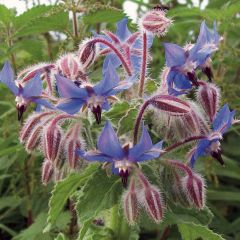
Borage seeds - Borago officinalis
- Flowering time April to October
- Height at maturity 60 cm
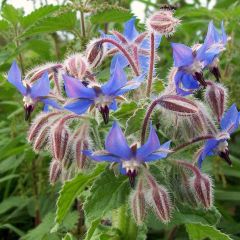
Borago officinalis
- Flowering time June to September
- Height at maturity 60 cm
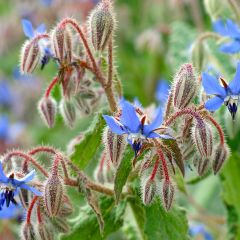
Borago officinalis - Blue Borage
- Flowering time August to November
- Height at maturity 40 cm
Our favourites
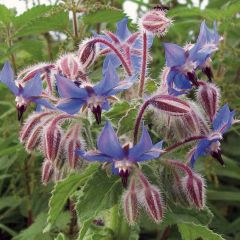
Borage - Ferme de Ste Marthe Seeds
- Flowering time June to November
- Height at maturity 60 cm
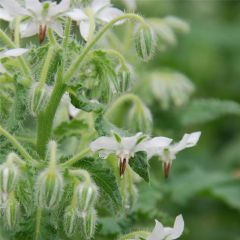
White Borage - Ferme de Sainte Marthe seeds
- Flowering time June to November
- Height at maturity 40 cm
Discover other Borage
View all →Available in 1 sizes
Available in 1 sizes
Available in 1 sizes
Available in 1 sizes
Available in 1 sizes
Available in 1 sizes
Available in 1 sizes
Available in 1 sizes
Sowing and planting
Where to sow and plant borage?
Borage grows easily in most gardens, but does not tolerate sub-zero temperatures. It disappears with frosts and is grown as an annual, but the plant self-seeds after flowering from year to year.
Easy to grow, it prefers deep, humus-bearing, light soils, not too dry but fresh, well-draining, and rather calcareous.
It likes non-scorching sun and will tolerate a semi-shaded position in our warmest regions.
Taller than wide, give it a spacious spot where it can thrive, as it self-seeds prolifically, an advantage for keeping a naturally flowering corner each year!
Borage’s blue or white flowers naturally find their place in the organic vegetable garden or in the herb garden, in herb beds where they attract many bees and butterflies while repelling flies and slugs!
It also has environmental benefits: it is an excellent green manure! When incorporated into vegetable garden soil, it will provide essential minerals as it decomposes and, when added to compost it will be a good activator, helping organic waste to break down more quickly.
With its pretty bushy habit and fresh flowering, it also fits easily into natural or wild gardens to add structure and lightness to borders or country-style beds.
In small spaces or on a balcony, it is also well suited to container growing and will be happy in a pocket vegetable garden!
When and how to sow borage?
Sowing borage is child’s play! Sow borage from March to June for harvest and flowering about 2 months later.
In open ground
Borage seeds are sown directly in place, after last frosts around May.
- After drawing a line, sow 2 or 3 seeds per hill in small holes 1–2 cm deep spaced about 40 cm apart,
- Cover seeds with a thin layer of soil,
- Firm soil with the back of a rake,
- Keep moist during germination,
- Thin out when plants have a few leaves to leave one plant every 25–30 cm,
- Water regularly to aid establishment,
- Pinch plants when 10 cm tall to encourage bushiness.
In seed trays
You can also sow in seed trays or in buckets from February under cover: transplant to garden when plants have 5–6 leaves; root is fragile, so transplant with care. Pinch seedlings when they reach 10 cm.
→ Succeed at sowing condiment seeds with our video tips!
→ Learn more about sowing borage in our tutorial!
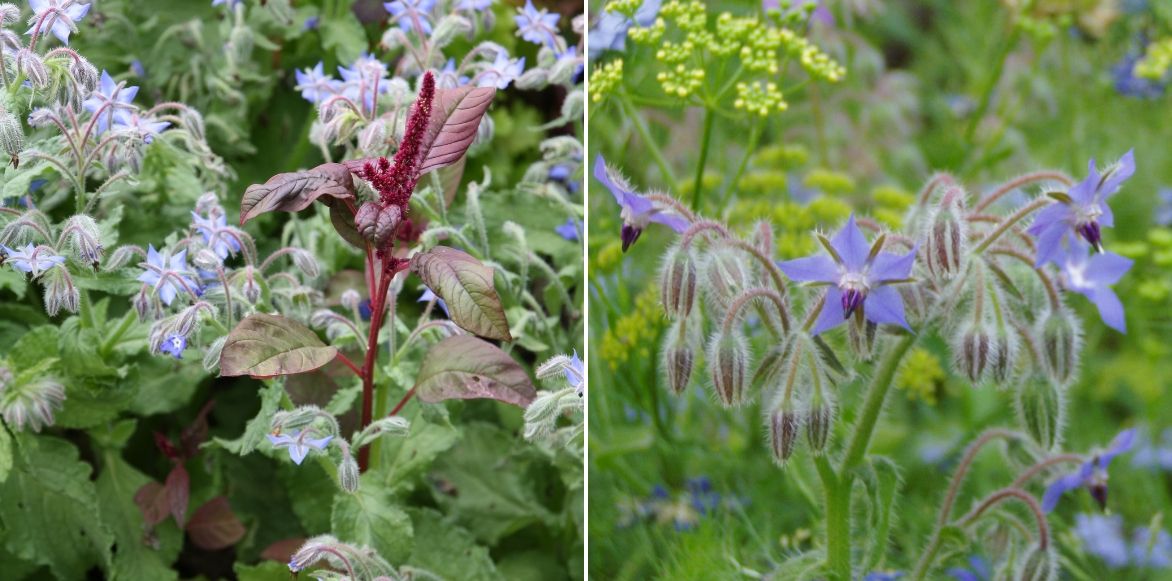
Borage with a purple amaranth and with the tangy flowering of dill
Read also
Best edible flowers for the gardenWhen and how to plant borage?
If you prefer to opt for our young borage plants in buckets, nothing could be simpler! Planting borage takes place in spring from March to June when temperatures have risen to around 15°C and preferably in a sunny spot.
How to plant borage?
In open ground
Space young plants 30 cm apart.
- Aerate soil well,
- Dig a hole three times the volume of the rootball,
- Spread gravel at bottom of planting hole,
- Place rootball,
- Backfill with garden soil,
- Firm down,
- Water copiously,
- Mulch.
And follow our advice to plant an annual properly!
In a pot
Borage is an invasive plant, quick to self-seed abundantly: planting in a pot helps limit spread. However, provide a pot at least 30 cm high for 2 to 3 young plants.
- At bottom of a container with drainage holes, spread a layer of gravel or clay pebbles,
- Plant rootball in a well-draining mix of garden soil, coarse sand and potting compost,
- Mulch around base,
- Water regularly whenever soil is dry.
Harvest, storage and use of borage
Harvesting flowers : Harvest of borage flowers is done as required, from May to September. Pick them fresh with scissors or by hand.
Harvesting leaves : Young leaves are harvested before flowering, when they are more tender and can be eaten in salad. If picked later, they should be cooked.
Harvesting seeds : Seeds are harvested between June and October, just before full ripeness. Dry them in the shade, thresh them and store in packets.
Uses : Borage’s star-shaped flowers are eaten fresh (they then retain all their qualities). They have a slight oyster-like, briny flavour and flavour omelettes, salads and decorate desserts with pretty bluish notes. They can also be dried to prepare infusions, herbal teas or fumigations and are widely used in herbal medicine.
Fresh, chopped leaves offer a tangy flavour reminiscent of cucumber and fresh gherkin and are eaten raw in salads or cooked like spinach to accompany meats.
Borage oil is obtained by cold-pressing the seeds; it cannot be produced at home.
→ Read our tutorial: Borage leaf soup: a simple, tasty recipe.
Storage : To preserve all medicinal qualities of borage, best consumed fresh. However, if you wish to dry it:
- Pick flowers at start of flowering
- Spread flowers and flowering tops on a rack or mesh in a dry, airy place away from light
- When dry, place them in airtight jars or boxes
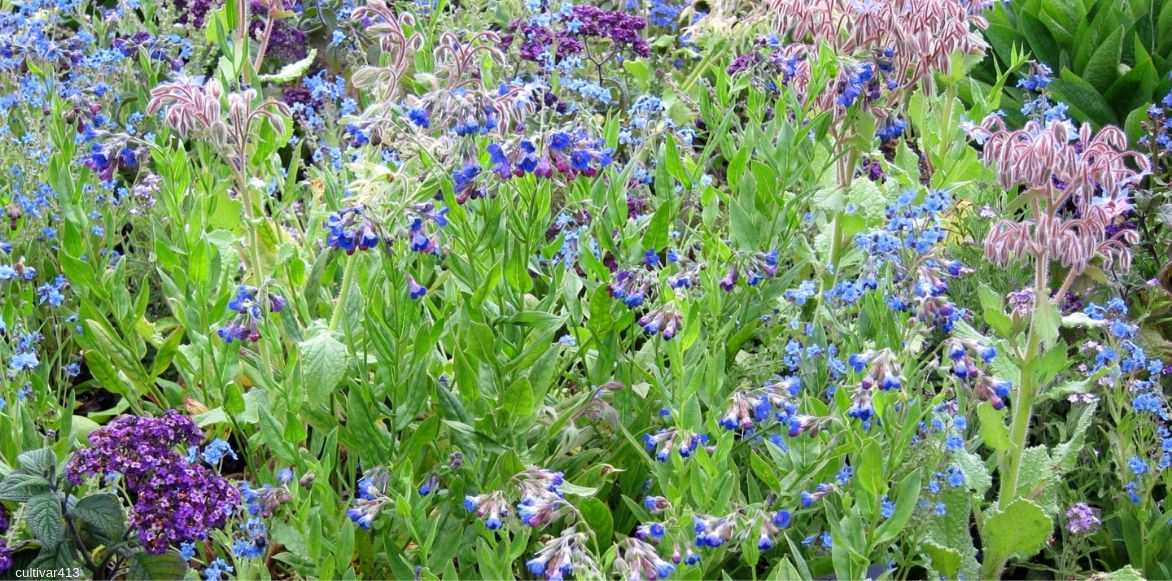
A pretty mix: Cynoglossum nervosum, Borago officinalis, Heliotropum
Benefits and virtues of borage
La borage has been used since Antiquity for its medicinal virtues. Borage flowers possess soothing, appetising, diuretic, depurative and sudorific properties (commonly nicknamed the sweat herb). They are also effective for treating bronchial conditions and rhinitis. Borage flowers are often used in herbalism mixed with other pectoral plants such as mallow, marshmallow leaves or poppy.
Leaves are also rich in vitamin C, magnesium and potassium.
Borage seeds are rich in unsaturated fatty acids; an oil is extracted from them with antioxidant, firming and protective properties very effective against skin dryness, to attenuate wrinkles or to treat certain dermatoses such as eczema.
Note: Borage leaves and flowers contain very small amounts of hepatotoxic substances (thesinine). Regular, prolonged consumption is not recommended, especially for pregnant women.
Care and maintenance
Borage is a very undemanding plant. It likes soil that stays fairly cool: water when weather is dry.
Mulch in spring to reduce watering.
Carry out regular hoeing and weeding to prevent weeds from overrunning the plant’s base.
Borage multiplies easily by its small seeds: spot spontaneous sowings, pull up small basal leaf rosettes in spring to prevent it becoming too invasive.
Let the best plants set seed to harvest some seeds for future sowings or pull up clumps just after flowering to avoid unwanted sowings (and bury them in your compost or in soil of your vegetable patch so they serve as green manure!)
Plant is not very susceptible to disease. It is increasingly grown for its repellent qualities: it repels slugs and cabbage white! At end of season, in hot humid weather, it can be susceptible to powdery mildew: leaves can then become covered with a white, felt-like coating. As prevention: water at the base without wetting foliage and spray nettle manure, a horsetail decoction or Bordeaux mixture. You will find our advice to combat powdery mildew in our dedicated sheet.
Multiplication
Borage self-seeds so generously that it guarantees perpetual harvests. If you already have a borage plant in your garden, harvest a few seeds just before their full ripeness, between June and October; otherwise choose from our borage seeds. It multiplies very easily by sowing directly in place in spring after frosts: find our advice to succeed with your sowing in the “How to sow borage” section.
Which plants make good companions for borage?
Borage naturally finds its place in an herb garden alongside other culinary herbs such as common sage, mint, angelica, Monarda, agastaches or dill. Plant it with other edible flowers and medicinal plants that you can use to make herbal teas or to dress salads.
With its generous, melliferous flowering, borage attracts many pollinating insects and will settle at the edges or in the heart of the vegetable garden, between strawberry plants (it has anti-fungal properties that protect strawberries), eggplants, lettuces and potatoes, especially as borage repels certain pest insects such as the cabbage white, keeps slugs and snails at bay, deters Colorado potato beetles, while attracting bees that help fertilise your vegetable plants.
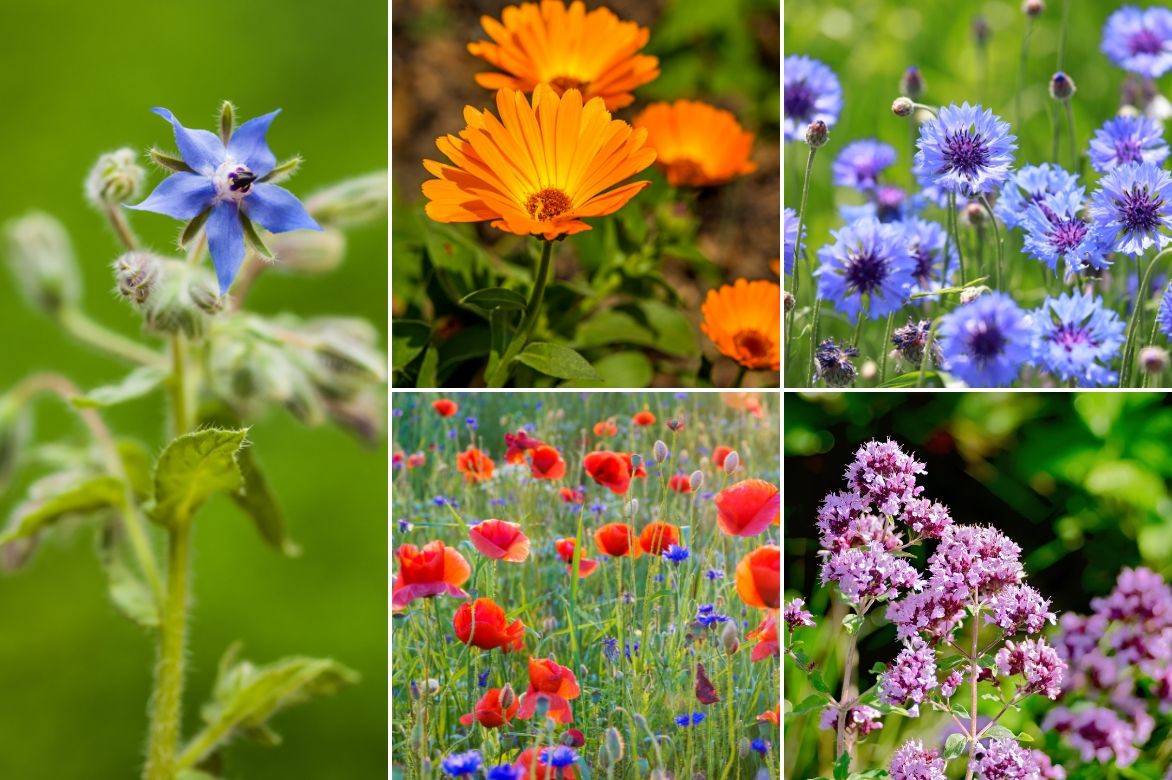
An example of a natural, colourful mixed-border combination: borage, calendula, cornflower, poppy and marjoram
With its simple, bushy habit, borage will thrive in natural and wild gardens, in the country-style beds of a cottage garden or in a vicarage garden, which mixes useful plants (vegetables, culinary and medicinal herbs), a multitude of perennials or annuals, and fruit trees. In a bed or an abundant mixed border, plant it with cornflowers, cosmos, dahlias, nepetas and other cottage perennials such as phlox, asters, astrances, lupins and yarrow…
Create a blue garden by pairing it with Salvia nemorosa, veronicas, Verbena hastata, campanulas, hardy geraniums, delphiniums and alliums. You will compose a very beautiful romantic-inspired scene by combining it with roses or by planting it at the feet of shrubby lavateras, buddleias or ceanothus.
Useful resources
- Discover our selection of 15 medicinal plants with many benefits… to grow in your garden!
- Our finest aromatic seeds are here!
- How to dry borage?
- Subscribe!
- Contents
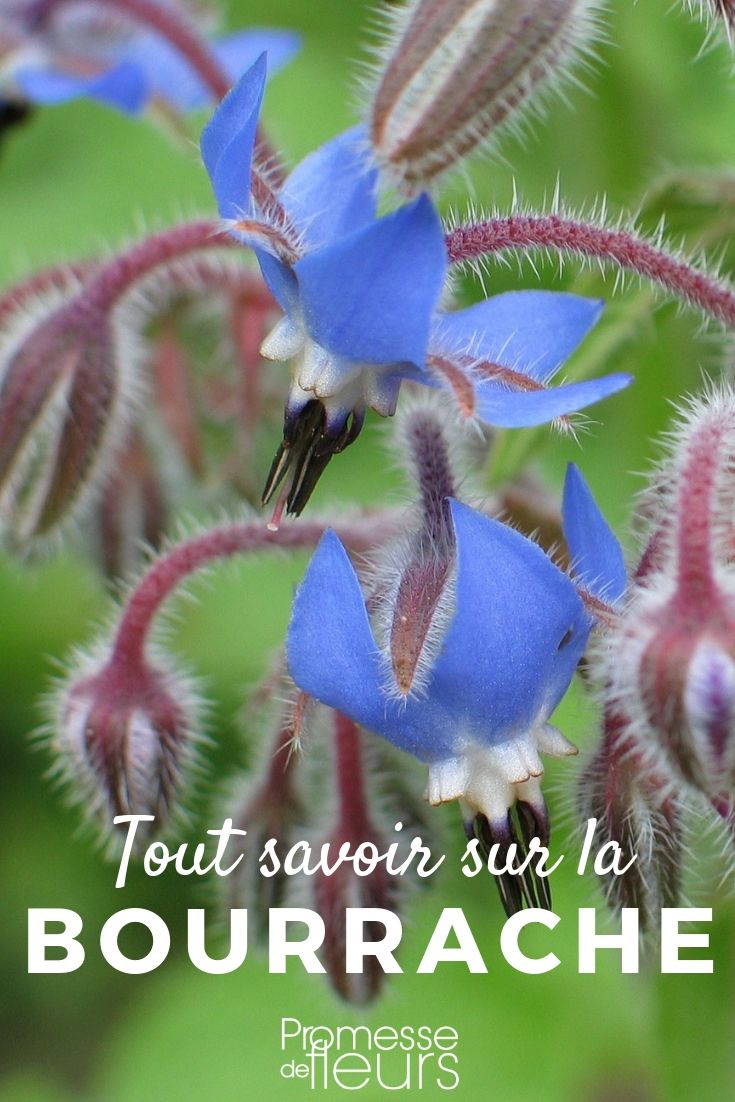

































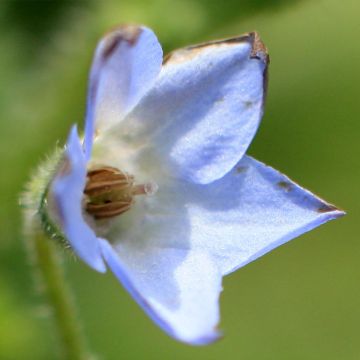


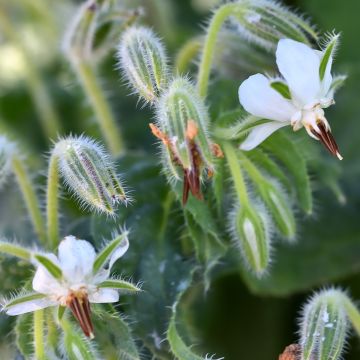
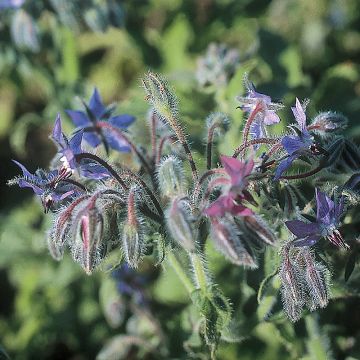

Comments